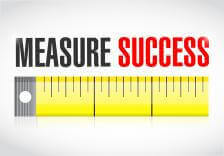How to Measure Your Productivity
Measuring your productivity can be a challenge. How do you know which aspects of your work dictate success? Get-It-Done Guy has the best way to measure your output.

That’s why they measure everything–so they can manage it. I’ve used that principle a lot in my life, especially at the gym. Too many people go to the gym thinking they should weigh themselves after every workout. They believe their weight measures fitness, so that’s what they measure, and that’s what they manage.
But that’s silly. For one, my goal is to be so manly that I walk into a room and people throw themselves at my feet. It ruins the effect if they have to pick me up and estimate my weight first.
Sponsor: This episode is sponsored by Backblaze, online backup for all your computer’s data. Get a risk-free, fully featured trial at Backblaze getitdone. No credit card required.
Besides, weight doesn’t measure studliness. Working out builds muscle, which is heavy. New, athletic you might actually weigh more than sit-on-the-couch-and-eat-bon-bons you. I’ve found measuring muscles directly gives a better idea of body shape. (Out of respect to you, my readers and listeners, I will omit the obvious, lowbrow joke about size being what matters.)
I also measure my exercise. Each week I do more reps or more weight of each exercise. I am very proud. After 8 months with my current trainer, last week I did 5 wide grip and 7 close grip pull-ups, unassisted. I am truly the manly-man I’ve always dreamed of becoming!
But there’s more to measure than just my manliness. Measurements can help you get better at what you do. The only question is: Which measurements do you choose?
Measurements Help You Get Better
In seventh grade, I discovered computers and fell in love. With computers, that is. Thinking ahead, it seemed typing would be a very important skill, so I signed up for touch typing. Every day we would measure how many words per minute we could type. We would also measure how many mistakes we made. Every day, we’d try to boost words-per-minute and reduce mistakes.
It became clear that boosting words-per-minute often introduced new mistakes, which actually lowered overall words-per-minute. Thanks to the measurements, we eventually worked out the winning strategy for improvement: Concentrate on accuracy and reducing mistakes first. With practice and attention, the speed would then follow. By the final exam, my speed was 72 words per minute on a manual typewriter. “Measurement works!” I proudly proclaimed. “Someday, I’ll use measurements to do 5 wide grip and 7 close grip pull-ups!” My teacher was very impressed. He also didn’t believe me and made me take the test again. But yes indeedy, 72 words per minute.
If your job involves a lot of typing, measuring and boosting your typing speed could make a huge difference. If I could boost typing speed from 72 words per minute to 102 words per minute, that 30 extra words a minute is 1,800 extra words an hour, or 14,000 extra words a day, or an entire book every week. Of course, that assumes that I do nothing but type continuously, but do you see how quickly it adds up? For a writer or heavy user of computers, words-per-minute is huge!
How did I get the extra speed? I switched to an electric typewriter and eventually to computer keyboards. When moving to the DVORAK keyboard layout instead of QWERTY, my speed stayed the same, but muscle fatigue reduced dramatically. Recently I bought a Das Keyboard computer keyboard with Cherry Brown mechanical switches. Having the right tactile feedback noticeably boosted my typing speed again.
Measurements Help You Estimate
Measuring typing speed helps get good at typing, but typing is just one building block. Good writing also involves outlining, research, editing, and formatting.
When I wrote my book, Get-It-Done Guy’s 9 Steps to Work Less and Do More, I wrote for a week, then edited my work so it was finished draft quality, then measured. Dividing the word count into the number of hours spent writing and editing, it turns out that my finished draft speed is roughly 400 final-quality words per hour. The outline had been done before that week, so the 400 WPH doesn’t include outlining time.
I’ve tried many things to boost this number, but at the end of the day, it is surprisingly consistent. And this is a Very Good Thing.
If Get-Fit Guy Ben Greenfield were to hire me to write an 800-word article on becoming a Manly-Man pull-up stud, it takes mere moments to envision my major points. “The article can be done in 5 minutes!” my brain declares. But history is more reliable. No matter how trivial it sounds, this is at least a two-hour job. I know that because measurement tells me that product-quality writing takes me an hour for every 400 words.
Own It

Conclusion
I walked into the office today and a young man I didn’t recognize ran over and threw himself at my feet. Thanks to measurements, my workouts are working!
“Sorry for the informality,” he said as he stood up. (He’s standing up? He’s not supposed to stand up until I acknowledge his admiration!) “You almost stepped on my contact lens. But I found it. I’m M.G., the new PR intern.” He’s shaking my hand, with a very firm handshake. He must work out. So he’ll appreciate my measurements.
“Pleased to meet you, M.G. I’m Stever. I did 5 wide grip and 7 close-grip pull-ups today.”
“That’s very impressive,” he said, with a sincere smile. M.G. and I are going to be great friends.
Then he added, “I started there, too. Now I do four sets of 8 wide grip and 8 close-grip pull-ups every day. You’ll get there. Just keep at it. I know you can do it!” Oh, so that’s how it’s going to be? Game on, MG. Game On!
This is Stever Robbins. I help high achievers accelerate or change careers by uncovering the skills and strengths they’ve used in their life that are valued by the people who can help them reach the next phase of their career, be they clients or employers. If you want to know more, visit SteverRobbins.com. Follow Get-It-Done Guy on Twitter and Facebook.
Work Less, Do More, and have a Great Life!
Measure success and ruler graph images courtesy of Shutterstock.
You May Also Like…






